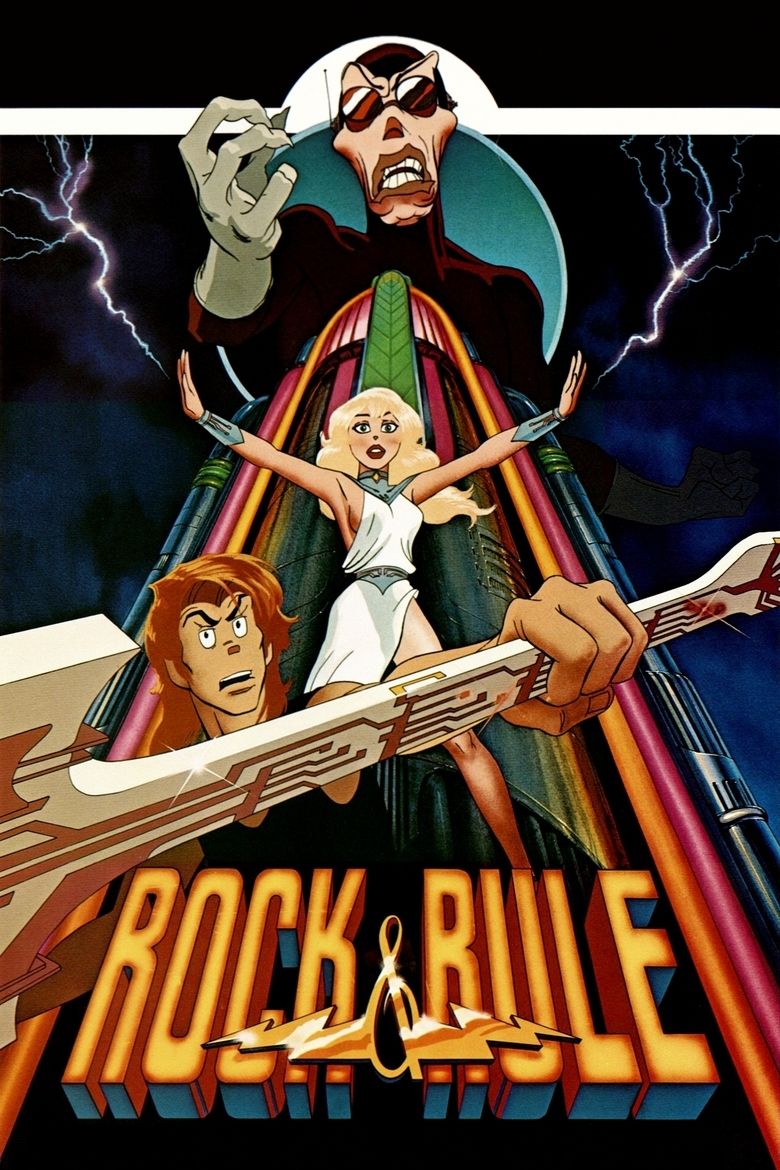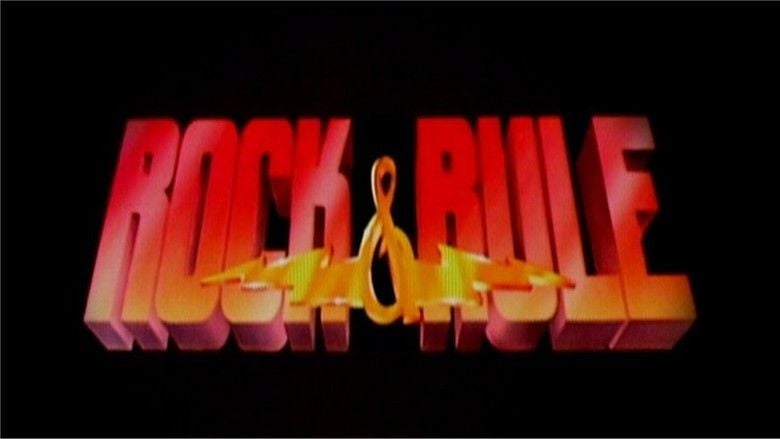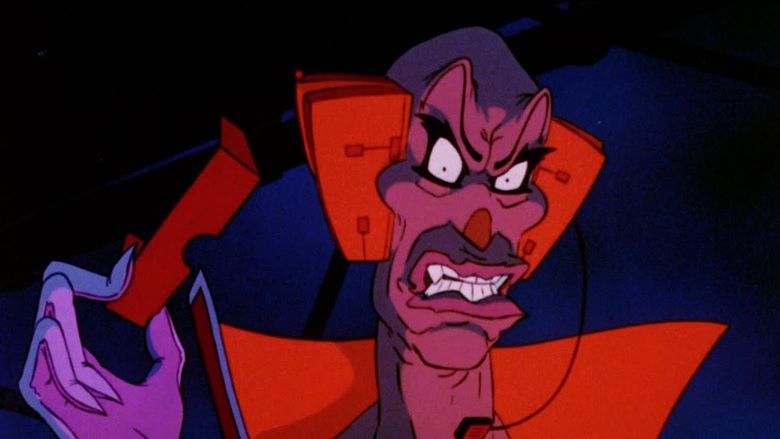Rock and Rule
6.8 /10 1 Votes
Country Canada | 6.8/10 IMDb Duration Language EnglishFrench | |||||||||||||||||||||||||||||||||
 | ||||||||||||||||||||||||||||||||||
Release date August 12, 1983 (1983-08-12) Writer Patrick Loubert (story), Peter Sauder (story), Peter Sauder (screenplay), John Halfpenny (screenplay), Anna Bourque (additional dialogue), Greg Duffell (additional dialogue), Larry Mollin (additional dialogue), Deanne Stillman (additional dialogue), David Young (additional dialogue) Tagline Sound you can see in the movie you can feel! | ||||||||||||||||||||||||||||||||||
Rock & Rule (known as Ring of Power outside North America) is a 1983 Canadian adult animated musical science fiction fantasy film from the animation studio Nelvana, marking the first time the company has made an animated production for adults. It was produced and directed by the company's founders, Michael Hirsh, Patrick Loubert, and Clive A. Smith. The film features the voices of Don Francks, Greg Salata, and Susan Roman. It was the studio's first feature film and the first English language one produced entirely within Canada.
Contents
- Plot
- Cast
- Production
- Release
- Controversy and reaction
- Alternative versions
- Home media
- Merchandise
- Reception
- Soundtrack
- References

Centering on rock and roll music, the film includes songs by Cheap Trick, Chris Stein and Debbie Harry of the pop group Blondie, Lou Reed, Iggy Pop, and Earth, Wind & Fire. The story takes place in a post-apocalyptic United States populated by mutant humanoids. With John Halfpenny, Patrick Loubert, and Peter Sauder at the helm of its screenplay, Rock & Rule was a heavily derived spin-off of Nelvana's earlier TV special from 1978, The Devil and Daniel Mouse. Its distributor, MGM, acquired United Artists at the time and the new management team had no interest in it. As a result, it was never released in North America except for a limited release in Boston, Massachusetts. It received minor attention in Germany, where it was screened at a film festival. It was funded in part by the Canadian Broadcasting Corporation, which had obtained the Canadian TV rights. A hard-to-find VHS was released at that time, followed by a laserdisc release. The film developed a cult following from repeated airings on HBO and Showtime and the circulation of bootleg VHS copies at comic book conventions booths (with Ralph Bakshi named as director). In 2005, Unearthed Films released a special 2-disc edition DVD of the film.

Plot

The intro states that in 1983 a nuclear World War 3 had erupted between the Soviet Union and the United States of America which destroyed each other and the human race, allowing a new civilization of mutated street animals to grow.

Mok, an aging yet legendary rock musician, is on the search for a very special voice that can unleash a powerful demon from another dimension, his dwindling popularity driving him to destroy the world in vengeance and immortalize himself in the process. After traveling around the world looking for the right voice, he returns to his hometown of Ohmtown, a remote, storm-ravaged village famous for its unique power plant.

Meanwhile, at a nightclub, Omar, Angel, Dizzy and Stretch perform in a small rock band. As Angel performs a gentle love ballad to a mostly empty audience, Mok hears her sing and his special ring goes off, and he realizes that Angel has the voice he needs. He invites Angel and the band to his mansion outside of town. Omar goads Mok and his henchmen, dim-witted brothers Toad, Stealthy, and Zip, upon meeting them, annoying Mok enough to suggest the band tries "Edison Balls"- a modern drug, which Omar and Stretch take, incapacitating them while Dizzy sneaks away to investigate. Meanwhile, Mok takes Angel on a stroll through his garden and tries to convince her to join him. Initially unaware of Mok's true intentions, she refuses to abandon her band. Unwilling to admit defeat, Mok kidnaps her and takes his blimp to Nuke York, where his summoning, disguised as a concert, will be performed.
After Dizzy snaps his band-mates out of their stupor, the trio find out what happened to Angel and they follow the blimp in a stolen police car. Before they reach Nuke York, they are arrested by a border guard. Meanwhile, Angel attempts to escape with the unwitting help of Cinderella, a sister of Mok's goons. While sneaking through the ventilation system, Angel overhears Mok confirming his plans with his computer. At this time, the computer informs Mok that the only way to stop the demon is with "One voice, One heart, One song", but when Mok asks who can do this, the computer replies that there is "no one". Angel and Cindy escape the building and head to the dance club "Club 666", unaware that Mok's henchmen are following them.
Dizzy's aunt bails out Omar and his friends, and tells them the whereabouts of Angel and Cindy. They follow, but Omar eventually bumps into Mok, who has already recaptured Angel and uses an impersonator to fool Omar into thinking that she is with Mok. To manipulate Angel, Mok captures the band and tortures them with a giant "Edison Ball" to force her to agree with his demands. He also brainwashes them to ensure that they stay out of the way. The Nuke York concert turns out to be a disaster because of an electrical failure. Mok relocates the summoning to Ohmtown, where the power plant has enough energy, while Zip expresses child-like doubts of whether they are doing good or evil by summoning the demon. During the second concert, a power surge causes overloads all over the city. The shock also brings Omar and his friends out of their stupor.
Omar, still believing Mok's earlier deception, refuses to help Dizzy and Stretch stop the concert. They go without him in a stolen police car but crash at the concert too late, as Mok forces Angel to summon the demon with her song. Before it can turn on a subdued Angel, Omar appears after a change of heart, and frees Angel from her electronic braces. The demon then attempts to attack Omar, who is pushed out of the way by Zip, seemingly at the cost of his own life, while Toad is enraged by Mok's callous reaction to his brother's demise. As the demon prepares to destroy their world, Angel tries singing to force the demon back, but her voice has no effect as Mok triumphantly gloats. However, as Omar joins in harmony with Angel, the creature is weakened and eventually driven back into its own dimension. Mok is thrown into the portal by Toad, and realizes in his last moments that "no one" did not mean that a person who could stop him did not exist, but that two voices and two hearts singing as one was needed for the counter-spell; he is then sealed away with the demon. The audience believes the confrontation to have been part of the concert's theatrics, and the band continues their song in triumph as Zip is revealed to have survived the attack.
Cast
Production
Rock & Rule was Nelvana's first animated feature film, and also the first Canadian animated feature to be produced in English. (Le Village enchanté, a 1956 production from Quebec, was the country's first overall.) The film spent several years in production and underwent many changes from the original concept, which was titled Drats! and aimed for children. The cost of production, $8 million in studio resources, nearly put Nelvana out of business. Over 300 animators worked on the film.
The animation was of unusually high quality for the era (it began production in 1979), and the special effects were mostly photographic techniques, as computer graphics were in their infancy. Computers were used to generate only a few images in the film.
Release
Prior to its completion, Rock & Rule was picked up by U.S. film studio MGM/UA in April 1982.
Controversy and reaction
Because of scenes involving drug use, implied satan worship, mild sexuality, and some profanity, the film could only be marketed to an adult audience. No soundtrack album was ever released (though some of the songs appeared as B-sides on subsequent singles by the musicians involved with the film). Commentary on the Special Edition DVD partially lays the blame for the film's lack of release in the U.S. on MGM. The DVD claims that management at MGM changed and the new overseers of the project were not as enthusiastic about the film as their predecessors. This caused script revisions and other changes which damaged the flow of the story, delayed its release date and raised costs. In the end, MGM was still unhappy with the film, so it was shelved.
Critic Janet Maslin of The New York Times commented: "The animation [...] has an unfortunate way of endowing the male characters with doggy-looking muzzles. In any case, the mood is dopey and loud." This has been cited by fans as an odd critique, since the characters were meant to be mutated descendants of dogs, cats and mice.
Though it had a limited theatrical release, the film soon developed a cult following in the United States as a result of late-night airings on the cable channels HBO and Showtime.
Alternative versions
The American distributor, MGM, disliked Greg Salata, who voiced Omar, and insisted that he be re-dubbed by an actor with name recognition, along with several edits being made to the film. Paul Le Mat was cast and Omar's obscenities were rewritten. Released under the title Ring of Power, the revised film was unable to find an audience at the box office, and it was this chopped version that quickly found its way to video and laserdisc.
The film was initially broadcast on the Canadian Broadcasting Corporation in 1984 (uncut, and including parental warnings). In 1988, the Canadian Broadcasting Corporation began airing the original cut, which featured extra footage, a different, clearer audio mix, the original voice of Omar, original shots that were replaced by alternate footage, and the shot of Zip, still alive, at the conclusion.
Home media
Original home video release copies of Rock & Rule are extremely difficult to find. MGM released the film on VHS video in 1984, and again on the Laserdisc format in 1986. Both of these editions soon went out of print. Bootleg copies of the film ended up being sold at comic conventions but these copies erroneously listed the film as being done by Ralph Bakshi. Soon after its demise in the home entertainment market, copies of the film could only be acquired by writing to Nelvana. The studio charged a fee of $80 to create and send a video copy of the film.
On June 7, 2005, Unearthed Films released the film for the first time on DVD. The first disc includes the theatrical cut (sourced from a 'Ring of Power' print) and the second disc includes the original cut of the film (though the original print was destroyed in a fire, this is taken from a VHS source); The Devil and Daniel Mouse, the TV special that was the inspiration for Rock & Rule; other features would be the alternate 'Ring of Power' intro sequence, a slightly different rough cut version of the ending and the trailer for Electric Dragon 80.000V.
On September 28, 2010, a Blu-ray Disc was released by Unearthed Films and has two versions of the film in one disc.
Merchandise
Because of MGM's disinterest in the film, very little promotion was given. The film was mentioned in an episode of Night Flight, when Lou Reed was interviewed. Marvel Comics published a comic book adaptation with authentic pictures from the film and its production in Marvel Super Special #25. According to letterer/assistant editor Michael Higgins, the comic sold well despite the film itself having only a very limited release.
Reception
On Rotten Tomatoes, the film scored a 72% audience rating. Kevin Ranson of MovieCrypt.com says that Rock and Rule "hints at a grander finished product if more time and money had been available." David Nusair of Reel Film Reviews found the film "...unpleasant and underwhelming." Keith Breese of Filmcritic.com says that "Rock & Rule is a masterpiece of outré animation and wildly ambitious vision and remains a triumph in animated feature film."
Soundtrack
References
Rock & Rule WikipediaRock %26 Rule IMDb Rock and Rule themoviedb.org
